Posted by LinkedSelling in B2B Lead Generation & Sales Development
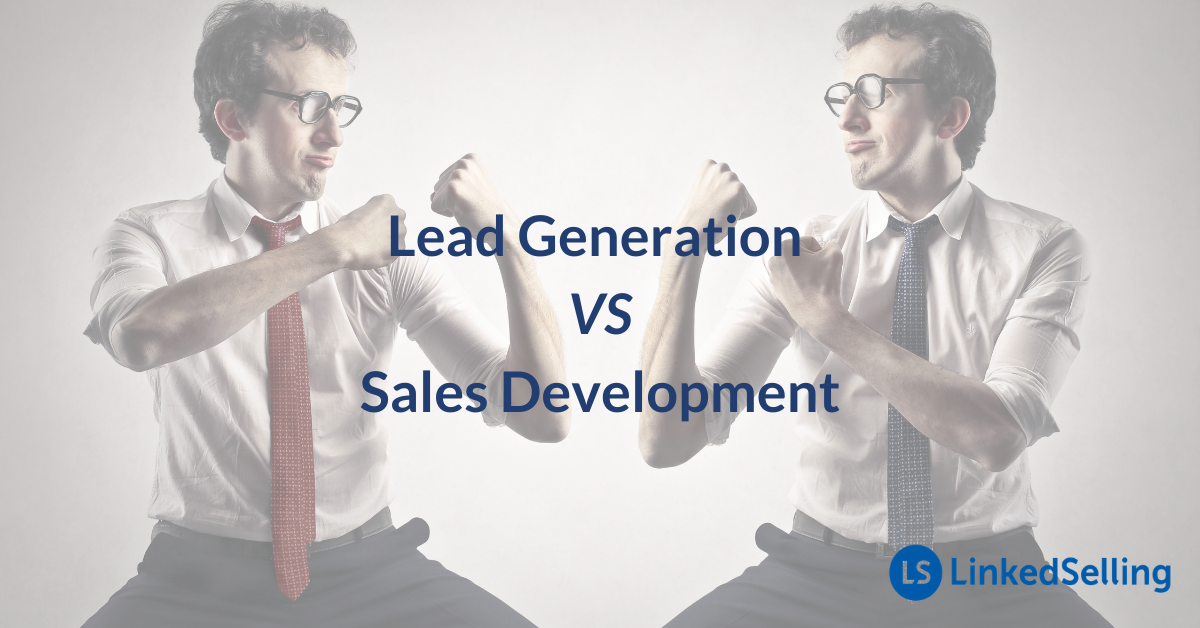
When it comes to getting new clients and generating new business, you’ve got a thousand ways to do it. However, in order to have predictability and be able to scale your business, you can’t just randomly “throw spaghetti at a wall” and see what sticks. Not if you want a sustainable pipeline of quality prospects ready to talk to your team. You need a system.
Part of that is understanding the buyer’s journey. You need to address every stage for your soon-to-be clients. From getting to know your industry, being introduced to your company, understanding your product or service, overcoming objections, to finally becoming a client. Each stage needs a different approach - and, more often than not, different people to handle the job.
That’s where things get murky though…
There are so many different stages:
- Marketing
- Lead Generation
- Prospecting
- Sales Development
- Closing the sale
I think an experienced marketer or salesperson would argue that covering the entire journey is important, but between the jargon, and the overlap between marketing and sales, it can be unclear to businesses who aren’t sure where to invest their resources, why or how.
Again, the question is how to do it systematically, so that it’s sustainable for your company and so that you’ve got marketing and sales working together.
Today’s post will break it down and make the distinction between “lead generation” and “sales development” in order to provide some clarity between the two and how they both need to fit into your marketing and sales sales strategy.
Thrive Leads Shortcode could not be rendered, please check it in Thrive Leads Section!
Definitions: Lead Generation vs. Sales Development
We went straight to the top and asked LinkedSelling President, Ben Kniffen to define and simplify these terms for us,
“Lead generation is the art and activity of identifying or getting someone to identify themselves
as a fit for your prospect profile.”
“Sales development is the art and activity of nurturing the leads you've generated
to be able to move through your sales pipeline.”
In other words, lead generation is focused on top-of-the-funnel activities, attracting and vetting new prospects, while sales development nurtures those prospects into booking appointments and creating sales opportunities for your sales team.
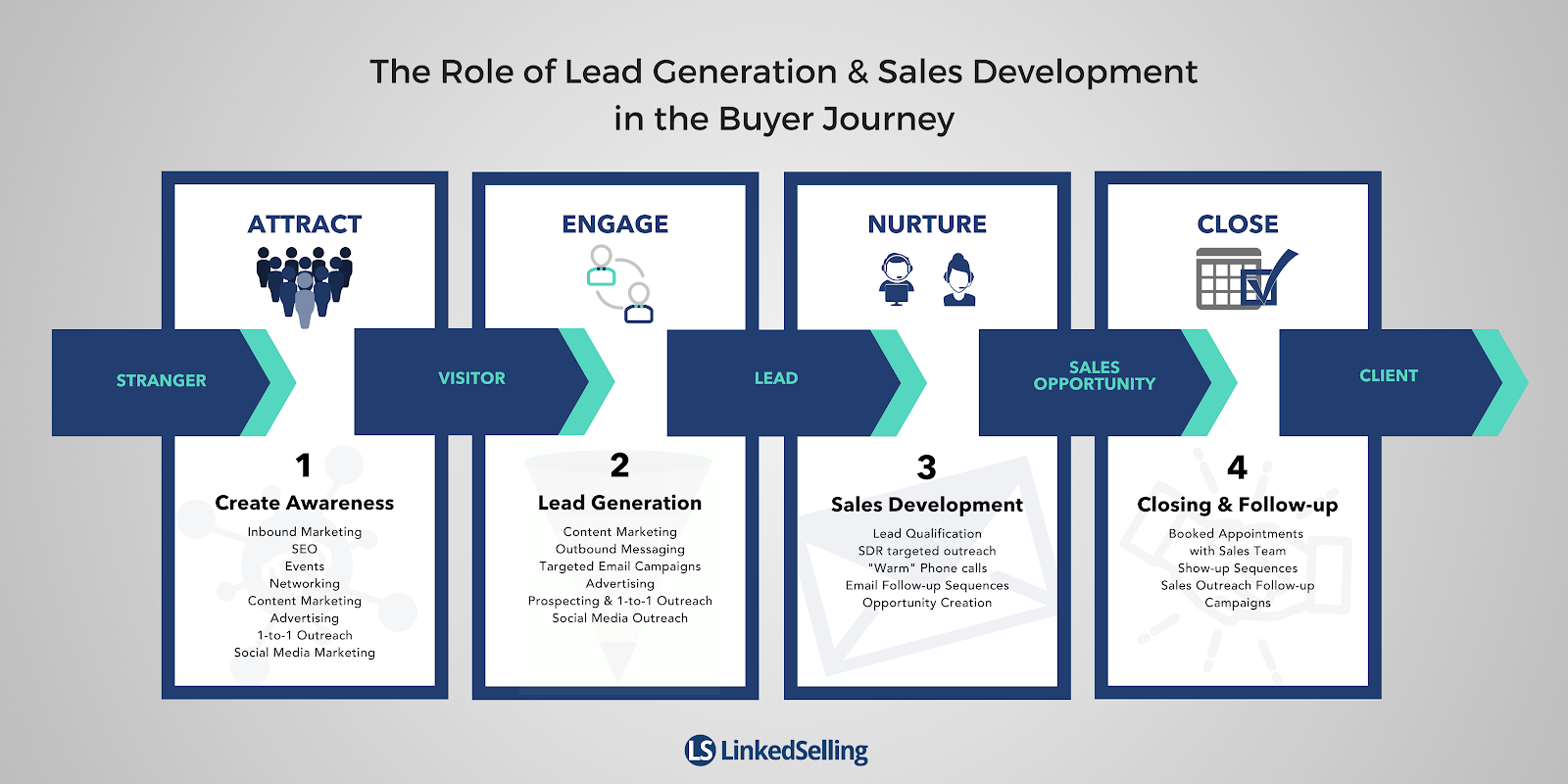
The Lead Generation Process
At this stage you’ve landed in front of your prospect, either by them actively searching and finding your or you actively searching for them. As mentioned above, lead generation is a top of the funnel activity, and this is often where Marketing acquires the lead. Here your prospect may or may not even realize they have a problem… or that your solution to their problem even exists.
The focus of the lead generation stage is to:
- Education
- Build authority & trust
- Present a solution to their problem
- And like Ben said above, to get them to identify themselves as a fit for your prospect profile
Common lead generation activities include both inbound and outbound efforts such as:
- Branding, which includes building authority in your market, increasing trust with your audience, and increasing community and client engagement
- Content Marketing through webinars, guides, reports, blogs and articles, podcasts and so much more
- Events & Trade-shows (either virtual or in-person)
- Social Media Ads - advertising on social media platforms such as Facebook, LinkedIn or Google, targeted websites
- Influencer marketing via strategic partnerships
- Personal outreach through messaging, email, or cold-calling
- And more
With many of these tasks, sales and marketing might overlap - for example, usually “marketing” doesn’t engage in one-on-one personal outreach while sales does.
***As a side note, another overlap area is of course sharing the knowledge of the audience; both marketing and sales have “insider” knowledge from either the data collected from marketing campaigns and/or the direct questions, comments, and concerns that the sales team hears everyday in speaking with prospects. This knowledge needs to be shared and used to refine the brand messaging and the type of content marketing that your audience will relate to and be moved to action by.
Now, it’s reasonable to assume that if you want more qualified sales appointments, you may not be able to do everything on that list all at once, but you’ll want to focus on what will WORK. Our answer - especially if you have limited resources - has always been to really hone in on who your audience is, define a clear prospect profile, and engage with them in personal outreach; to build a personal relationship.
However, the more you can do to build authority and trust, including providing valuable content (ie specific and relevant), the more receptive your prospects will be to starting real business conversations. This is why we always promote a multi-channel lead generation strategy, especially because your prospects do a lot of their own research.
The data shows that prospects are researching vendors now more than ever and they rely heavily on reviews and recommendations from peers, friends and family.
- In 2016, 62% of B2B buyers were relying more on peer recommendations than on their own research.
- And, according to State of B2B Procurement study from Acquity Group, some 94% of B2B buyers report conducting some degree of research online before making a business purchase
As shown in the chart below, they are taking more of the buyer journey into their own hands through personal research and recommendations and out of your marketing funnel and away from your sales team.
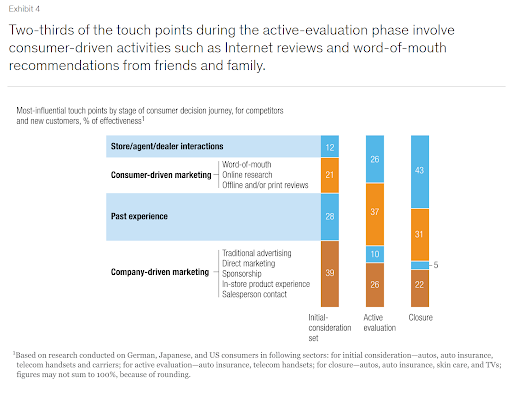
How to address this?
First, ensure that your company provides excellent service and that your clients are engaged so that they’ll be willing to provide recommendations and referrals that potential prospects will consider.
Second, use a multi-channel lead generation approach to increase the amount and types of touchpoints with your prospects. They’re not just on one channel. You shouldn’t be either.Thrive Leads Shortcode could not be rendered, please check it in Thrive Leads Section!
The Question of Branding and Lead Genereation: It’s Really About Relationships and Authority in Your Market
Branding is often seen as a “soft”, indirect way to sales. However, that’s not always the case.
This is a good place to look at the data around how encouraging prospects to action, through content and branding, share an inherent relationship in sales. Neil Patel explains,
“These actions are ultimately intended to culminate in a sale. [...] A strong brand or “high brand value” can solve many common problems before they occur.
Therefore, linking brand value to ROI is a matter of showing a causal relationship between strong branding and the elimination of issues that can impact sales.”
This is why your brand messaging needs to be on point and why your content, and even your outreach, needs to be both consistent and focused on helping and educating your prospects about how they can address and fix their pain points and problems.
Lead Generation Challenges for Businesses
One of the biggest challenges for many companies is that they skip the first part of the buyer journey and want to jump straight to the sale. Research shows that at any point, only 3% of your prospects are ready to buy… the majority need to become familiar with you, need to trust you, and need to build a relationship with you, even if that relationship is only that they consume your content regularly.
No one explains it better than Chet Holmes, author of The Ultimate Sales Machine, with his Demand Generation Pyramid:
While Chet’s experience revealed that only 3% of your target market are actually ready to buy at any time, on the flipside, it means there’s a 97% chance that they’re not ready to hear your offer and will immediately shut you down - simply because they’re not ready yet.
This is why 49% of B2B companies report higher ROI by investing in relationships instead of acquisition marketing:
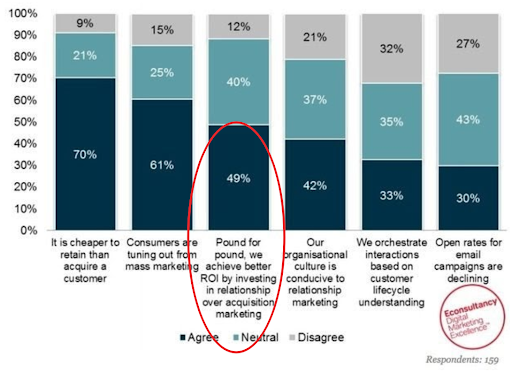
Another big problem we see is that B2B businesses neglect the relationship aspect with their prospects and even clients and still rely on old-school PR to handle their image. Turning again to Niel Patel, who describes the problem very well,
“For one, B2B companies have been slow to respond from the traditional PR-dominated branding to a now marketing-dominated branding.
The best practice used to be leaving your image in the hands of your PR team.
But with the rise in consumer research, this trend is now damaging companies that are still opting for the old school.
The room for growth is astronomical, and B2B companies that fail to focus on their brand and market it effectively are essentially neglecting their future and their clients.
Your name, reputation, or brand could be the only factors preventing your clientele from leaving you.
Or worse, it could be what’s driving them to look for other options.”
Let’s move on to sales development and why it’s important to consider as a separate process from lead generation.
The Sales Development Process
In our own definition above, Ben defined sales development as “the art and activity of nurturing the leads you've generated to be able to move through your sales pipeline.”
Based on that definition, sales development essentially turns your prospects gained from top-of-the-funnel lead generation activities into more serious sales opportunities by getting these prospects to book phone calls and start real business discussions.
At this point in your prospect’s buyer’s journey, they’re most likely actively looking at other options. They are familiar with their problems and the options available to them. In our opinion, this is a primary opportunity for you to reach out to them directly in a few different ways:
- Reach out to these prospects via phone, email, messaging direct mail (the more personal connection the better)
- Further qualify the prospect
- Continue to educate and entice prospects
- And move them further down the pipeline by setting them up with a sales rep, or “closer” who will close them and turn them into a client.
The primary goal at this stage of the sales process is to connect with as many prospects as possible, qualify them, and give them the next step.
Such next steps could be a:
- Demonstration
- Strategy call
- Assessment
- Consultation
- Technical call
We’ve found that incorporating a Sales Development Representative (SDR) is a vital aspect to this stage of the funnel.
Active Campaign explains the role of an SDR very well,
“SDRs educate, answer questions, and send resources to potential customers.
They contact every lead and determine who stays and who goes. [...]
Without the SDR’s qualification process, the sales cycle takes much longer
(because people focused on closing deals are talking to leads who aren’t looking to buy).
Leads fall through the cracks or sign with a competitor.
Sales development representatives are quality control for sales leads.”
Two of the primary tools involved in an SDR’s outreach are simply email and phone calls. Among other processes, we’ve developed customized outreach sequences to be sent out over a 90 day period, similar to the Agoge sequence popularized by Sam Nelson of Outreach.io.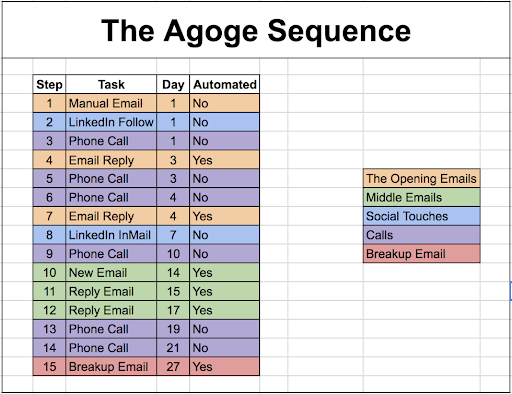
The purpose of this is to:
- Stay top of mind, building on the momentum that a prospect has gained by opting in to content
- Continue to educate and entice
- Show that the company we’re communicating on behalf of is composed of real human beings (building trust), not just a corporate wall to hide behind
- And of course, to guide the prospects to the next step.
On top of phone outreach, our sequences include quick, short, to the point - and VERY personable - emails. These emails provide content that help educate, answer common questions, address pain-points and provide social proof & testimonials.
Thrive Leads Shortcode could not be rendered, please check it in Thrive Leads Section!
What’s the Big Deal About Calling Prospects?
A note about making calls.
First of all, these phone calls aren’t strictly “cold calls.” These are calls to prospects who have somehow or at some point opted-in to content, watched a webinar, or have gotten on our database list.
Our SDR’s call them, reference the content consumed if possible, answer basic questions and set up an appointment with a sales rep who will go into depth addressing the prospect’s questions and hopefully close the client.
Secondly, there are a few myths about buyers not wanting to speak to sales people, especially early on in the buying process. One of which we alluded to previously… that because buyers do so much of their own research, they don’t want to speak with sales people.
However, the data from Rain Group Center for Sales Research debunks that in a survey of 488 buyers:
Don’t neglect your phone calling!
This data shows that 71% of buyers are open to hearing from sellers when they’re “looking for new ideas and possibilities to drive stronger results to improve [their] business.”
That’s a primetime touchpoint opportunity you definitely want to take advantage of.
Another graphic from that same survey shows the top two means of communication are indeed email and phone calls.
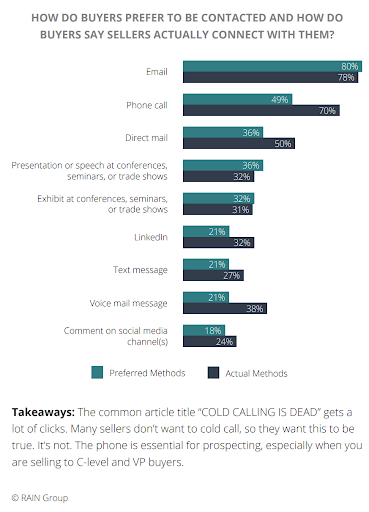
Incorporating both email and phone calling into a systematic, repeatable process helps the SDR’s stay organized, track the prospect buyer journey, and affect sales further down the funnel.
To Recap: Lead Generation Vs. Sales Development
So which is more important? Both lead generation and sales development are important processes that address different stages of the buyer’s journey, from top of the funnel, to mid and bottom-of-the-funnel prospects. Between the two, they encompass the tasks necessary to get a prospect on the phone with your sales team where the prospect has an opportunity to become a client.
As part of our multi-channel outbound strategy, we incorporate both lead generation and sales development tasks on behalf of our clients so that we’re not just delivering leads.
Our ultimate goal is to use multi-channel methods to deliver consistent, predictable, and scalable sales opportunities for our clients.
Of course, each business we work with is at a different stage, and some solutions are not appropriate for every business. That’s why, if you’re interested in developing a strategic system that will keep your sales team busy with consistent and quality sales opportunities, the best option you have is to speak with our Director of Client Strategy.
Together you’ll discern what options are best suited for your company and a positive ROI for your bottom line.
Click below now to schedule a no-obligation appointment at no cost to you and find some clarity to help you make the best decision for your sales team and business growth.
Thrive Leads Shortcode could not be rendered, please check it in Thrive Leads Section!
